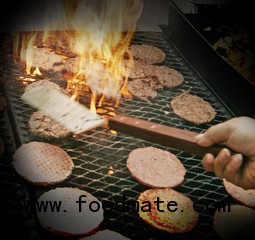
While it may be hard to imagine the all-beef patty as an environmental menace, air-quality regulators have long known that the smoke from burgers cooked on grills can spew 14 tons of microscopic, lung-damaging particles each day into the region. That's more than double the daily output from big rigs.
"An 18-wheeler diesel-engine truck would have to drive 143 miles on the freeway to put out the same mass of particles as a single charbroiled hamburger patty," said Bill Welch, principal development engineer at the University of California, Riverside's Center for Environmental Research and Technology. "In my 18 years researching this, I haven't found a more difficult source to control."
Welch and his students have sizzled more than 4 tons of ground beef since starting their research in 1994. They have cooked 4,000 burgers just since May to test devices that would capture the offending particles before they reach the air.
They've also charbroiled chicken, fish and other meats, but burgers far and away produced the most pollution.
On Sept. 19, the team fired up a commercial grill like those used by mom-and-pop restaurants and steakhouses. They were testing one of five pollution control devices in a $450,000 study funded by the South Coast Air Quality Management District and San Joaquin Valley Air Pollution Control District in California.
As part of the study, UCR researcher George Karavalakis is probing the health effects of burger smoke. When grease drips onto a flame it forms soot, which is composed of very fine particles that work their way deep into the lungs. But it's unclear yet whether the smoke from cooking meat is as toxic as, for example, diesel soot.
The health consequences of diesel emissions are well documented. Fine particles have been linked to asthma, cancer, heart attacks and more than 5,400 premature deaths per year, according to the California Air Resources Board.
In 1997, the air district adopted emission control requirements on chain-driven charbroilers like those used at Burger King, Carl's Jr. and other fast-food restaurants. Those chain-driven conveyors, with flames on the top and bottom, now have catalytic converters that capture 90 percent of the smoke.
But there was nothing cost effective or technically feasible at the time for the charbroilers with flames on the bottom, Welch said.
"There was nothing out there 10 years ago, but now there's new technology," he said.
A condition of the current study was that devices being tested could be installed for an up-front cost of $30,000 and annual maintenance of $10,000, Atwood said. The cost would have to be considerably less before a rule would be imposed, he said.
Daniel Conway, spokesman for the California Restaurant Association, said installing expensive equipment would pose a hardship for some eateries.
"That would be a substantial cost that would be quite burdensome for many restaurants," he said. "That could be (equivalent to the salaries of) several employees."
The device under scrutiny by the UCR researchers drew smoke from above the ventilation hood, collected the particles in fog inside a cylinder, then directed them into a spinning unit that captured them for disposal. The researchers measured the air stream before and after it passed through the control device.
The South Coast air district is under more pressure to impose controls after the Bay Area Air Quality Management District adopted regulations for under-fired charbroilers that take effect next year, a deadline set with the intention of forcing development of the technology.
"Since our air pollution is so severe here, federal and state law requires us to put into place any and all feasible measures to reduce emissions," said Sam Atwood, air-district spokesman.





